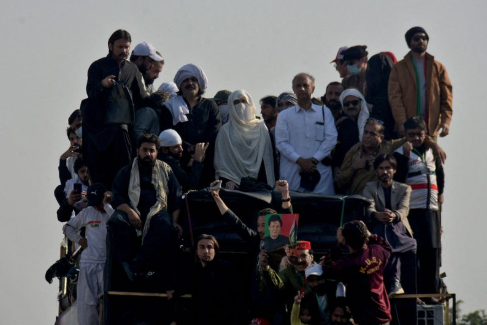
PAKISTAN witnessed another socio-political crisis as a protest by former Prime Minister Imran Khan’s supporters, who came out in thousands and marched towards Islamabad’s D-Chowk, turned violent last week.
The protesters demanded the release of the Pakistan Tehreek-e-Insaf (PTI) leader and other party functionaries. Rallies, sit-ins and protests have been a signature move for the cricketer-turned-politician, who is incarcerated in Rawalpindi’s Adiala Jail and is embroiled in over 150 cases. Imran had issued a ‘final’ call to his supporters for a protest on November 24; this time, the faces behind the protests were Bushra Bibi, Imran’s wife, who, till now, had abstained from public appearance, and Ali Amin Gandapur, Khyber Pakhtunkhwa Chief Minister and a close aide of Imran. The protesters faced a severe crackdown by the security forces. There have been conflicting reports on the number of people dead and arrested as a result, but the fact remains that it was the use of brute force that resulted in the protesters’ retreat.
Imran enjoys immense popularity and support within Pakistan and has demonstrated great resilience by not opting to go into exile, which has been a customary conduit for former political (and military) leaders in Pakistan. Imran’s mass appeal has been driven by his unwavering claim and position to stand for Pakistan against the corrupt dynastic politics and his blatant challenge to the all-powerful Pakistan military, which has been held responsible for most of the economic and political woes of Pakistan.
This is ironical since Imran’s tenure as Prime Minister from August 2018 to April 2022 was marked by glaring misjudgments, witch-hunting of opponents, lack of governance, faulty decisions/projections, economic downfall and misconstrued foreign policy choices. Imran was the military’s favourite at one point and its choice for the 2018 General Election, when he enjoyed the full patronage of the military to win the elections and trounce Nawaz Sharif. In 2018, Imran was projected as a clean and corruption-free leader, driven by a welfare agenda, and one who would alter the course of Pakistan’s growth and its image on the global stage. Eventually, his strains with the deep state resulted in his scandalous exit from the Prime Minister’s office in 2022.
After his exit, he has kept the momentum of his support base going, even when he was not allowed to contest the 2024 elections and his party was denied the election symbol. His support base has expanded from the urban middle class to all levels of society, where the masses see him as fighting for Pakistan, even though his track record demonstrates a complete inability to manage Pakistan’s complex political, economic and security challenges.
The current crisis is primarily a fight between Imran and the Army chief, Gen Asim Munir. They have a well-known history of hostility. The controversial and much-debated 2024 elections brought the Sharifs in power and they currently enjoy the trust and support of the military establishment. The weak civilian regime in Pakistan, which lacks credibility, has no intention of asserting itself against the military’s writ and will prioritise its own survival in power. Critical constitutional changes have been made with the passing of the recent 26th Amendment Act, with the intention to manage the functioning of the judicial system and ensure Imran’s political isolation. Gen Munir, the most powerful man in the country, has got an extension and he will continue to serve till 2027, if not beyond.
The protests have resulted in the resignations of the top brass of the PTI and the faultlines within the party are expected to deepen. Frustrations within the party will grow, given the arrests of PTI workers. Imran might seem to have limited options left after his call for the November 24 march. But given his obsession with street politics, he is unlikely to give up soon and his next call for a protest might not be far away. But whether he will be able to steer the same support after the experience of the latest protests remains a question.
Imran’s release seems unlikely anytime soon, unless there is an agreement between him and the establishment. While his allegations against the political and military elite may have succeeded in triggering the sentiments of the masses, they are unlikely to trigger a major change in the power dynamics or bring him any respite from the legal cases.
The establishment has expanded its powers and strengthened its control on the state institutions where Imran, in the recent past, enjoyed fractional support. The current crisis once again presents an old game with different actors in Pakistan. The actors change, intensity varies, tactics differ, but the bottomline remains unaltered — a military-run state with sufficient power and resources manages to crush any rebellion or opposition questioning its legitimacy and power.
Pakistan is experiencing a multi-dimensional crisis: the economy is struggling to recover from the combined fallouts of fiscal deficit, high inflation, unsustainable energy prices and meeting the requirements of the structural restructuring set up by the International Monetary Fund; a series of terror attacks by the Tehrik-e-Taliban Pakistan targeting security personnel; relentless opposition by the oppressed Baloch and Pashtuns in Balochistan and Khyber Pakhtunkhwa even as their voices have been suppressed by the use of brute tactics, including forced disappearances.
A nuclear state with a multifold crisis does raise serious concerns regarding not only how Pakistan will shape up in the coming years but also throws up larger regional implications.






